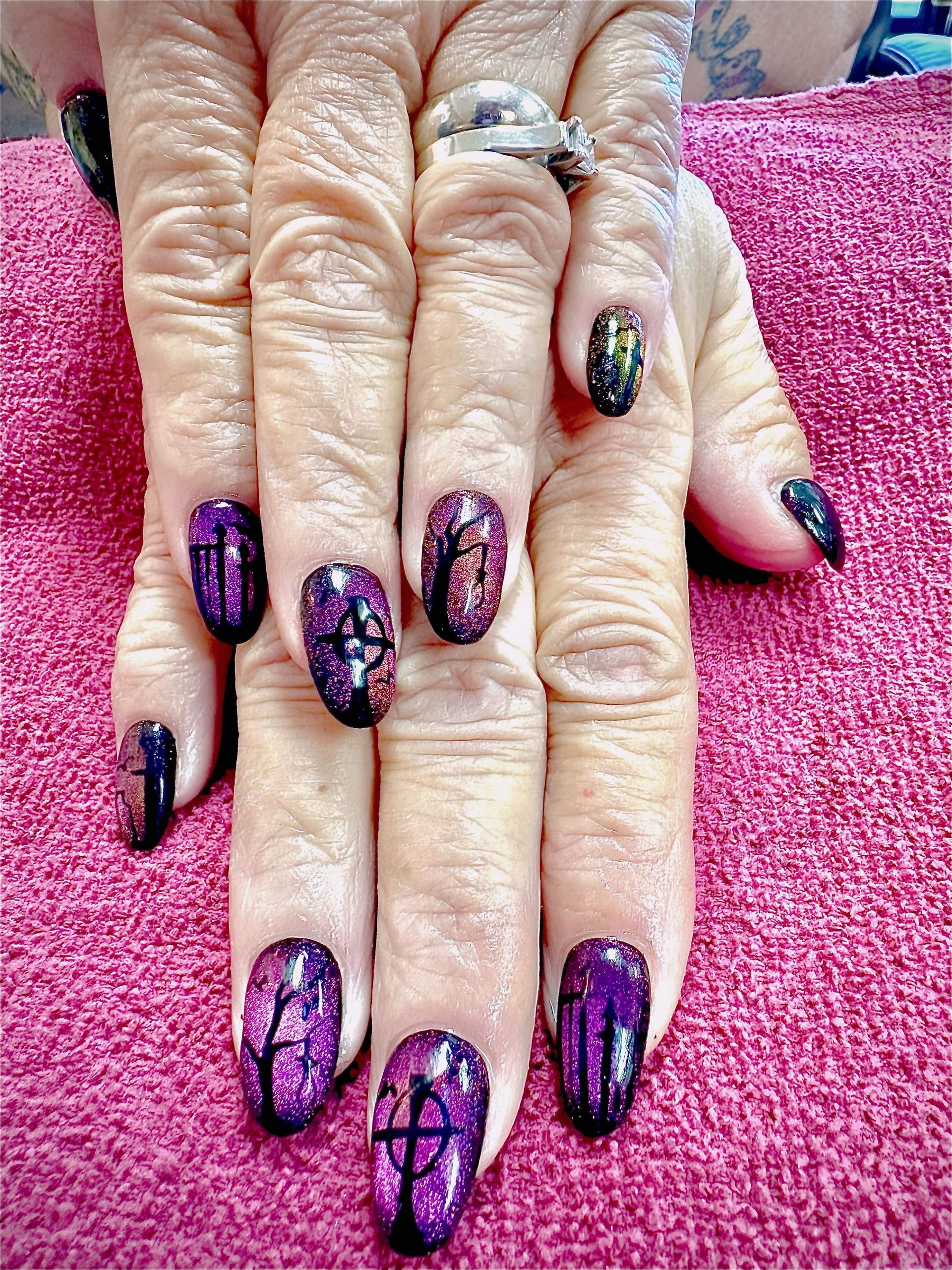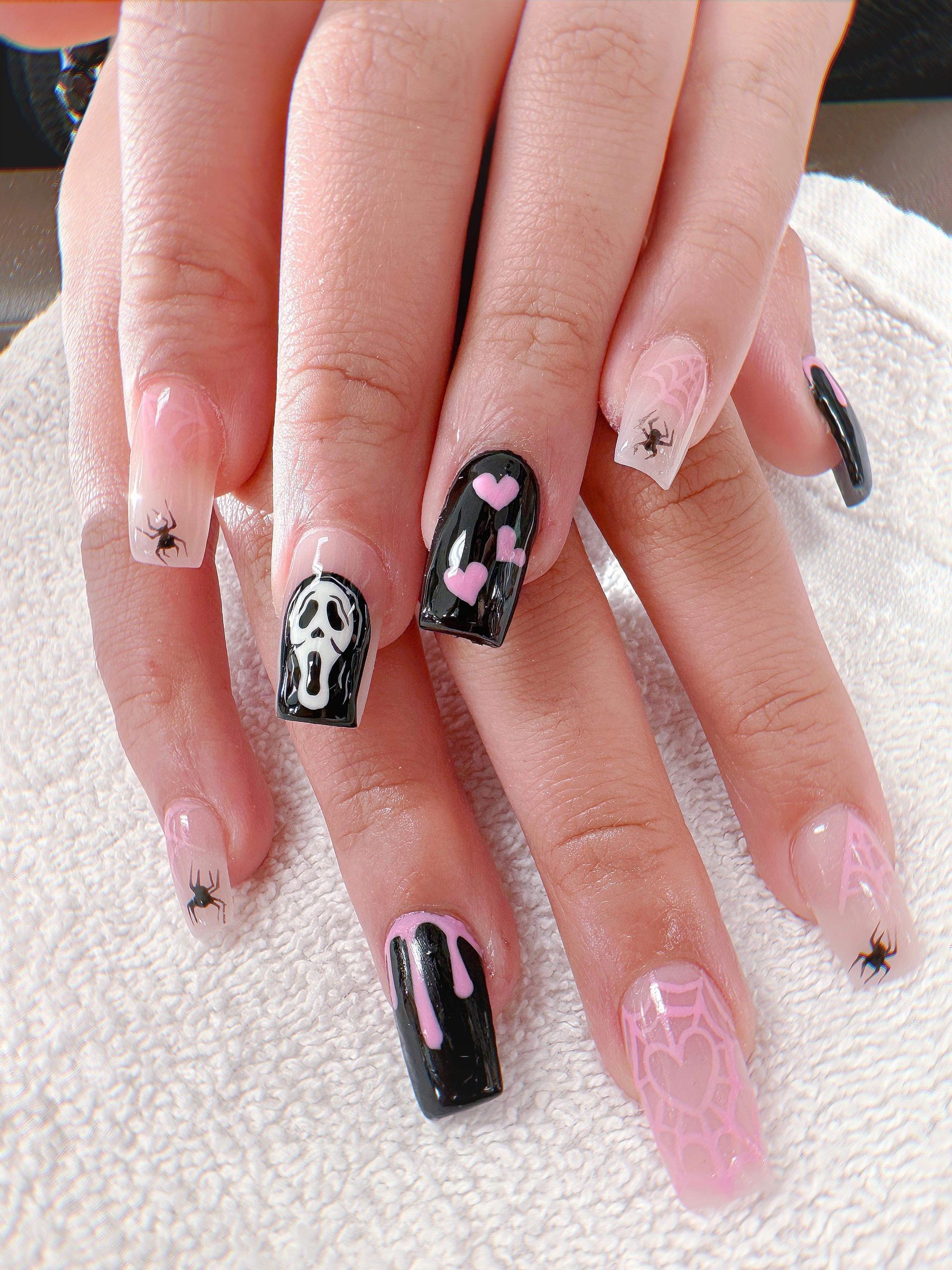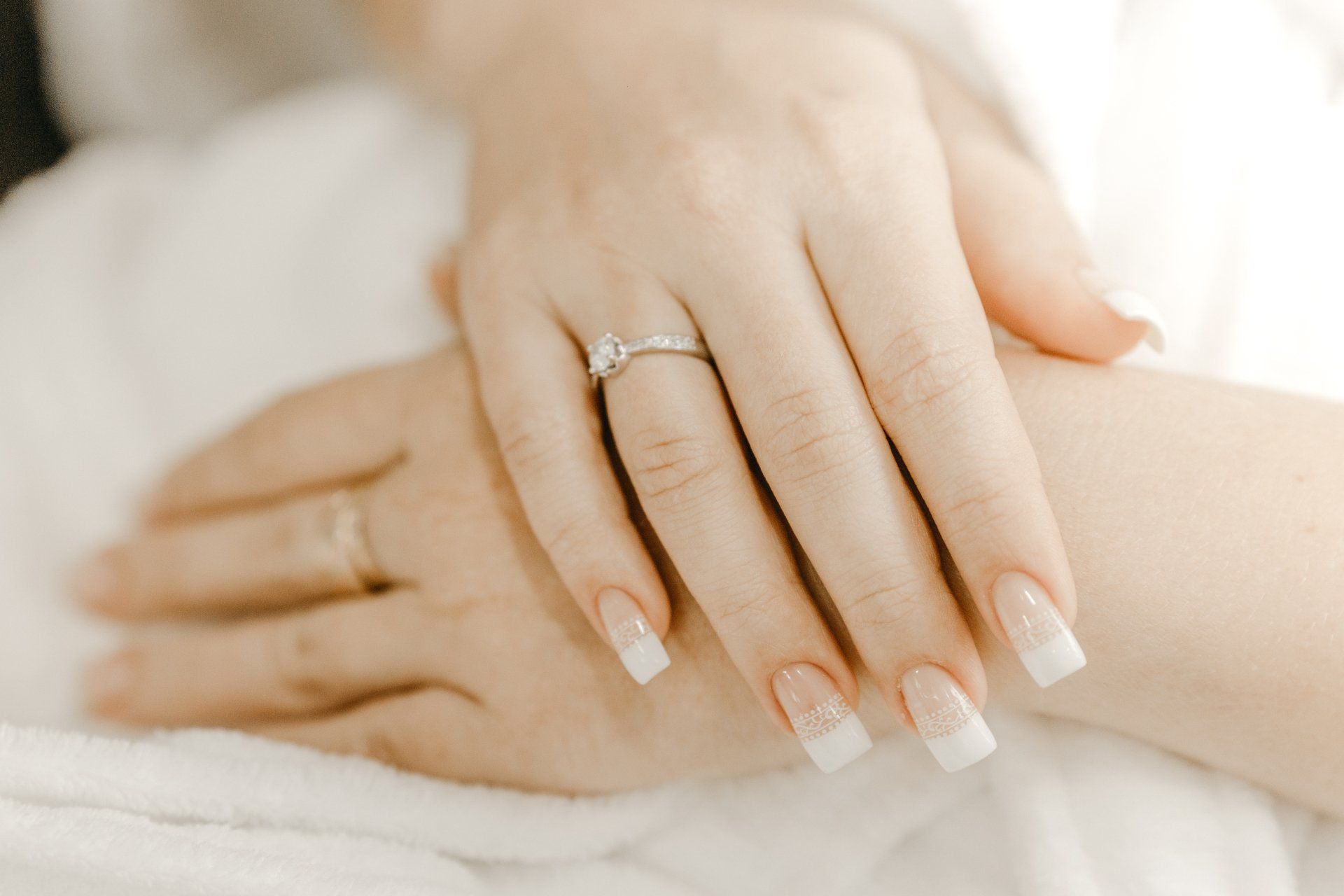Gel Manicure Aftercare Tips
For proper gel manicure aftercare, avoid hot activities for 24 hours, limit water exposure, and wear gloves for chores. Moisturize daily with cuticle oil to enhance nail health and polish durability. Protect nails from damage by avoiding using them as tools and refreshing the top coat every few days. Handle acetone carefully during removal to prevent dehydration. Give nails breaks between manicures to maintain their strength. Promptly address any nail issues, seek professional help if needed. For flawless gel nails, following these aftercare tips is key to long-lasting beauty and health.
Key Takeaways
- Avoid hot activities and harsh chemicals for 24 hours.
- Moisturize nails daily with cuticle oil or cream.
- Protect nails during chores with gloves.
- Refrain from using nails as tools to prevent damage.
- Refresh manicure with a top coat for longevity.
Precautions for the First 24 Hours
After getting a gel manicure, it is crucial to take certain precautions during the first 24 hours to maintain the longevity and appearance of your nails. To ensure the durability of your gel manicure, it is important to avoid hot activities such as hot baths, saunas, or prolonged time in direct sunlight. Heat can cause the gel polish to lift or peel off prematurely, compromising the overall look of your nails.
Additionally, limiting hand exposure to water and harsh chemicals is paramount in the first 24 hours following your gel manicure. Household chores or activities that involve frequent hand washing should be minimized to prevent the gel polish from weakening or chipping. Wearing gloves while cleaning or doing dishes can help protect your nails and extend the life of your manicure.
Moisturize Daily for Nail Health
Moisturizing your nails daily is essential for maintaining their health and strength after a gel manicure. Nail hydration plays a crucial role in preventing dryness and brittleness, which can lead to breakage and damage. To ensure optimal nail hydration, apply a nourishing cuticle oil or cream around the nails and massage it in gently. This will not only keep your nails moisturized but also promote healthy cuticles, contributing to overall nail health.
Proper nail hydration also enhances polish longevity, keeping your gel manicure looking fresh for longer. Hydrated nails are less likely to chip or peel, allowing your manicure to stay intact for an extended period. Additionally, moisturizing daily can improve nail strength, reducing the risk of breakage and promoting healthy nail growth.
Incorporating a moisturizing routine into your daily nail care regimen is a simple yet effective way to maintain the health and appearance of your gel manicure. By prioritizing nail hydration and cuticle care, you can enjoy beautiful, strong nails that withstand the test of time.
Protect Your Nails During Chores
When it comes to protecting our gel manicures during chores, wearing protective gloves is paramount. These gloves act as a barrier between our nails and harsh chemicals found in cleaning products, preventing damage and premature chipping. Additionally, being mindful of prolonged water exposure can help maintain the integrity of our gel manicures.
Wear Protective Gloves
To safeguard your gel manicure and prevent damage, it is essential to wear protective gloves while engaging in household chores. Proper glove etiquette is crucial to maintain nail polish longevity. When wearing protective gloves, make sure they fit well to avoid water seeping in. Choose gloves made of a durable material like rubber or latex to protect your nails from harsh chemicals and rough surfaces. Remember to remove any rings or bracelets that could cause damage to the gel polish. By incorporating protective gloves into your household routine, you not only protect your gel manicure but also ensure the health and longevity of your nails. Prioritizing this simple step can make a significant difference in preserving your beautiful manicure.
Be Mindful of Water
Being cautious around water is essential to protect your gel manicure while tackling household chores. To safeguard your nails, consider using waterproof nail polish or applying a top coat for extra protection. When cleaning or doing dishes, wear protective gloves to prevent water from weakening the gel polish. After chores, avoid submerging your hands in water for prolonged periods. Instead, opt for quick tasks or use waterproof gloves. To maintain your gel manicure, employ proper drying techniques. After exposure to water, gently pat your nails dry with a soft towel instead of rubbing them vigorously. Following these precautions will help preserve your gel manicure and keep your nails looking fabulous for longer.
Avoid Using Nails as Tools
Using your nails as tools can lead to chipping, cracking, or lifting of your gel manicure. To maintain your manicure and prevent damage, it's crucial to avoid using your nails for tasks like opening cans, scratching off labels, or tightening screws. These activities put unnecessary strain on your nails, causing the gel to weaken and chip. Instead, opt for using proper tools or asking for assistance to prevent any harm to your manicure.
Additionally, refrain from using your nails to peel off stickers or open packages. This can not only damage your gel polish but also weaken your natural nails, leading to potential breakage. Remember, your nails are jewels, not tools. By being mindful of how you use your hands, you can extend the longevity of your gel manicure and keep your nails looking flawless for longer. Prioritizing nail care and avoiding using nails as tools is essential for maintaining the beauty and health of your manicure.
Refresh With a Top Coat
For a longer-lasting and refreshed gel manicure, applying a protective top coat is essential. A top coat not only enhances the nail polish longevity but also provides numerous benefits for your nails. When applying a top coat, ensure your gel manicure stays vibrant and chip-free for an extended period.
To maximize the benefits of a top coat, follow these application techniques. Begin by applying a thin layer of top coat over your gel manicure, ensuring to seal the edges for added protection. Wait for the top coat to dry completely to prevent smudging and promote a glossy finish. Reapply the top coat every few days to maintain the shine and durability of your gel manicure.
In addition to enhancing the aesthetic appeal of your nails, using a top coat contributes to overall nail care benefits. It provides an extra layer of protection against daily wear and tear, helping to prevent chipping and peeling. By incorporating a top coat into your aftercare routine, you can enjoy a longer-lasting gel manicure with beautifully maintained nails.
Handle Acetone With Care
Handle acetone with care, as it is a potent solvent commonly used in gel manicure removal procedures. Acetone can be harsh on nails if not handled properly, potentially leading to dryness, brittleness, and peeling. To prevent nail damage, it is crucial to use acetone sparingly and follow proper removal techniques. When soaking nails in acetone for gel polish removal, ensure that the exposure time is minimized to reduce the risk of dehydration and weakening of the nail plate. After soaking, gently push off the softened gel polish with an orangewood stick instead of forcefully scraping it, which can damage the nail surface.
Additionally, remember to moisturize your nails and cuticles after acetone exposure to replenish lost moisture and maintain nail health. By handling acetone with care and employing proper removal techniques, you can effectively remove gel manicures without compromising the health and strength of your nails.
Give Nails a Break Between Manicures
To maintain strong and healthy nails, it is beneficial to allow for intervals of rest between gel manicures. Giving your nails a break between manicures helps prevent damage and allows them to recover. During this break, focus on nail strengthening by using nail treatments rich in vitamins and minerals. These treatments can help nourish and strengthen your nails, promoting their overall health.
In addition to nail strengthening, it is essential to pay attention to cuticle care during this resting period. Moisturize your cuticles regularly with cuticle oil or cream to keep them hydrated and prevent them from becoming dry and brittle. Healthy cuticles contribute to the overall health of your nails and promote strong nail growth.
Address Any Issues Promptly
When it comes to gel manicure aftercare, addressing any issues promptly is crucial for maintaining nail health. If you notice any signs of damage or discomfort, we highly recommend seeking quick salon fixes to prevent further problems. By tackling nail concerns swiftly, you can ensure that your nails stay healthy and beautiful in between manicures.
Nail Health Concerns
At the first sign of any concerns regarding the health of your nails, it is imperative to seek prompt attention and care from a qualified professional. Nail care is essential for maintaining healthy nails after gel manicures. Proper manicure techniques, such as avoiding excessive filing or rough cuticle removal, can help prevent damage. If you notice any redness, swelling, pain, or changes in nail color or texture, it's crucial to address these issues promptly. Ignoring nail health concerns may lead to more severe problems. A professional can provide guidance on how to care for your nails and recommend treatments if needed. Remember, your nail health is important, so don't hesitate to seek help when needed.
Quick Salon Fixes
For immediate solutions to any issues at the salon, promptly address concerns with your nail technician to ensure proper care and maintenance. If you notice any chips or lifting of the gel polish, don't hesitate to ask for a quick fix. Your technician can easily touch up the affected areas to maintain the integrity of your manicure. Additionally, if you have specific nail art trends in mind that weren't executed to your satisfaction, discussing this promptly can help resolve any discrepancies. Furthermore, if you feel that your cuticles require special attention, your technician can recommend a suitable cuticle care routine to keep them healthy and well-maintained. Effective communication with your technician is key to achieving the best results and addressing any salon-related concerns promptly.
Professional Removal Is Essential
Ensuring the proper removal of a gel manicure by a professional is crucial to maintaining the health and integrity of your nails. Professional removal helps prevent damage to the nail bed, cuticles, and surrounding skin that can occur when attempting to remove gel polish at home. During a professional removal, trained technicians use techniques that minimize the risk of nail damage, such as gently soaking the nails in acetone and carefully scraping off the gel layers without causing harm.
Attempting to remove gel manicures at home can lead to nail dehydration and weakening. Home remedies like peeling or picking off the gel polish can strip the nails of natural oils, leaving them dry and brittle. This can result in nail breakage and peeling, causing discomfort and compromising the overall health of your nails. Professional removal ensures that your nails are properly hydrated and cared for throughout the process, helping to maintain their strength and appearance. By entrusting the removal to a professional, you are investing in the long-term health of your nails.
Frequently Asked Questions
Can I Swim or Take a Hot Bath After Getting a Gel Manicure?
Yes, we can swim or take a hot bath after getting a gel manicure, but it's essential to follow specific guidelines. Chlorine exposure may affect the manicure's longevity, so it's advisable to wear gloves while swimming. After swimming or bathing, moisturizing is crucial to maintain nail health and prevent drying. By taking these precautions, we can enjoy our activities while keeping our gel manicure intact and our nails healthy.
How Often Should I Trim My Cuticles to Maintain My Gel Manicure?
When it comes to maintaining our gel manicure, cuticle health is key. Trimming our cuticles regularly not only promotes manicure longevity but also ensures overall nail health. By practicing proper cuticle trimming techniques and nail care maintenance, we can keep our manicure looking fresh and pristine. It's recommended to trim cuticles every 1-2 weeks to prevent them from overgrowing and potentially affecting the durability of our gel nails.
Is It Safe to Apply Cuticle Oil on Top of a Gel Manicure?
Absolutely, it's safe to apply cuticle oil on top of a gel manicure. Cuticle hydration is crucial for nail health, and using cuticle oil can help maintain moisture levels, preventing dryness and promoting healthy nail growth. By applying cuticle oil regularly, you can protect your cuticles and improve the overall appearance of your nails. Remember to gently massage the oil into the cuticles for best results.
Can I Use Hand Sanitizer Frequently With Gel Manicured Nails?
Yes, we can use hand sanitizer frequently with gel manicured nails. However, it's essential to follow up with proper care. It's advisable to moisturize hands with hand cream regularly to combat dryness caused by sanitizer. Additionally, consider using a nail strengthener to maintain the health and strength of your nails. By incorporating these steps into your routine, you can enjoy the benefits of gel manicures while keeping your nails in top condition.
How Long Should I Wait Before Getting Another Gel Manicure After Removal?
We recommend waiting at least two weeks before getting another gel manicure after removal. This waiting period allows your nails to recover fully from the previous application. It promotes nail health and proper regrowth, ensuring the longevity and durability of your gel polish. Frequent applications without adequate break times can weaken your nails over time, so it's essential to give them time to breathe and rejuvenate between gel manicures.
Gallery
Related Topics Nail Salon Services
Choosing the Right Gel Manicure for You
Gel Manicure vs. Regular Manicure: Understanding the Differences
How Long Does a Gel Manicure Last?
The Process of Getting a Gel Manicure
Removing Gel Manicures Safely and Effectively
Tips for Maintaining Your Gel Manicure
Understanding UV and LED Gel Manicure Lamps
What to Expect During a Gel Manicure Appointment
Find Us
Contact
Contact Us
We will get back to you as soon as possible
Please try again later
nail salon
salon
nail salon
spa
nail
salons
nail salons
nail salon
nail salon
nails
services
nail
salon
business
nail salon
nail salon
nail salon
manicure
manicure
manicure
manicure
manicure
best
quality
nail salon springfield
nails salons
nails shop
salon
manicure
spa
nail
salons
nail salons
manicure
nail salons
beauty salon
shellac
venus
nails salon
committed
technicians
business hours
spa
top
nails spa
mani
solar
dipping
nail salons
place
contact
beautiful
salons
nail salon
nail salon
nail salons
nailbar
nails
gel nails
nail enhancements
self-care
artificial nail
nail salons
nails
services
nail
nail salon
nail salon
nail salons
nailbar
nails
gel nails
nail enhancements
self-care
artificial nail
best nail
nails
services
nail
What are the best nail salons for kids?
What are some popular services for nail salons?
What are people saying about nail salons in Springfield, MO?
What is the best nail salon in Springfield?
manicure nail nail salon gel and shella nail designs nail salons nailbar nails nails salon nails salons nails shop salon salons shop gel and shella nail designs gel and shella nail designs nail designs beauty salon manicure salon for nails Discover the Ultimate Nail Experience at Manicure Nail SalonDiscover the Ultimate Nail Experience at Manicure Nail Salon
Are you in search of the perfect nail salon nails near you nail salon nail salon Manicure Nail Salon nail salon nails meet top-notch pampering. Our salon is your go-to destination for all things nail salon, providing a haven of relaxation and rejuvenation.
At Manicure Nail Salon, we take pride in being one of the finest nail salons in nail salon. Our expert technicians are dedicated to crafting the most stunning and long-lasting nail art in the area. Whether you're looking for a classic manicure or a trendy nail design, we've got you covered.
Nail Salons Springfield: nail salon
What sets us apart from other nail salons Springfield has to offer? It's our commitment to excellence and attention to detail. Our professional staff knows that the beauty of your nails lies in the finer points. With an array of colors, designs, and styles to choose from, your nail salon Springfield experience will be truly unique.
At our nail shop, we use only the highest-quality products to ensure the health and longevity of your nails. Our exclusive range of nail polishes and treatments will leave your nails looking flawless and feeling stronger than ever.
Nail Artistry That Shines
Whether you're getting ready for a special occasion or simply treating yourself to a well-deserved break, our nail artistry will leave you speechless. Our technicians are skilled in the latest nail techniques, from intricate nail extensions to breathtaking nail designs.
Nail Services for Every Occasion
At Manicure Nail Salon, we offer a wide range of nail services to cater to your specific needs. From classic manicures and pedicures to luxurious spa treatments, our salon is your one-stop destination for all your nail care needs.
nail salons springfield, nail salons springfield
If you're in Springfield, Missouri, and in search of the finest nail salon has to offer, look no further than Manicure Nail Salon. Our dedicated team is ready to pamper you with the best in nail services. Come visit us today and experience the ultimate in nail luxury.
Don't miss out on the opportunity to transform your nails into works of art. Book your appointment at Manicure Nail Salon now, and let us elevate your nail game to new heights.
The Art of Manicures: Nail Enhancement
When it comes to self-care and pampering, one of the most popular choices for individuals in Springfield, Missouri, is indulging in exquisite manicures. A well-executed manicure can transform not just your nails, but your entire outlook, leaving you feeling confident and rejuvenated. In this comprehensive guide, we delve into the world of manicures nail salon nail enhancement services and salons that cater to all your nail needs.
The World of Manicures
Exploring Manicures
Manicures have come a long way from being simple nail grooming sessions. Today, they are an art form in their own right. A professional manicure involves a meticulous process that includes cleaning, shaping, and beautifying your nails. Whether you're looking for a classic manicure or something more adventurous, Springfield has it all.
Nail Enhancement: Taking Manicures to the Next Level
For those seeking to elevate their nail game, nail enhancements are the way to go. Nail enhancement techniques encompass a variety of options, including nail extensions, gel overlays, and intricate nail designs. These techniques not only add length and durability to your nails but also offer an opportunity for creative expression.
Springfield's Manicure Scene
The Best Manicure Salons
Springfield boasts a thriving manicure scene, with numerous salons offering top-notch services. Among them, a few stand out as true gems for nail aficionados.
- Nail Nirvana: This salon is a haven for those seeking the perfect manicure. Their skilled technicians offer a wide range of services, from basic manicures to dazzling nail enhancements.
- Elegance Nails: Known for their attention to detail, Elegance Nails is a favorite among Springfield residents. They specialize in gel manicures that last for weeks, keeping your nails looking impeccable.
Exploring Nail Enhancement
Nail Extensions: A Game Changer
Nail extensions have become increasingly popular, offering the possibility of longer and more glamorous nails nail salon nail enhancement experts use high-quality materials to ensure durability and natural aesthetics.
Gel Nails: Beauty and Durability
Gel manicures and nail enhancements have taken the beauty industry by storm. These long-lasting options provide both strength and style to your nails, making them a preferred choice for many.
Nail Care Tips
Maintaining Your Manicure
To make the most of your manicure and nail enhancements, it's essential to follow some basic care tips. Regularly moisturize your cuticles, avoid using your nails as tools, and schedule routine touch-ups to keep your nails looking pristine.
Conclusion
nail salon manicures and nail enhancements is thriving. Whether you're seeking a classic manicure or adventurous nail art, Springfield's manicure scene has something for everyone. Discover the artistry and craftsmanship of Springfield's finest nail enhancement salons, and indulge in the luxury of perfectly groomed nails. Your journey to impeccable manicures starts right here in manicure.
Elevate Your Beauty: Unique Manicures at Uniquely Herr's Nail Salon
In the world of manicures, where precision meets creativity, Uniquely Herr's Nail Salon stands as a beacon of excellence. Located in the heart of the city, this salon is not just a place for routine manicures, but a hub of artistic expression and nail enhancements that redefine beauty standards.
The Artistry of Manicures
Manicures are no longer just about neat and trimmed nails. They are an art form, a canvas upon which skilled technicians create miniature masterpieces. At Uniquely Herr's, manicures are elevated to an art form that combines precision and innovation.
Imagine stepping into a salon where your nails become the focus of attention, where they are treated with utmost care and expertise. Uniquely Herr's Nail Salon offers a range of manicure services, from classic to avant-garde, all designed to pamper and beautify your nails.
Exploring Nail Enhancement
A World of Possibilities
Uniquely Herr's is not just about manicures; it's about nail enhancement possibilities that are boundless. Whether you desire longer nails, intricate nail designs, or the elegance of gel overlays, this salon has it all.
Nail enhancements at Uniquely Herr's are a fusion of artistry and technology. The technicians are adept at using high-quality materials to create nail enhancements that not only look stunning but also stand the test of time.
Nail Extensions: The Game-Changer
For those yearning for longer nails, nail extensions are a game-changer. Uniquely Herr's takes this to the next level with the latest techniques and materials. Whether you opt for the natural look or the bold and dramatic, nail extensions are the perfect solution.
Gel Nails: Beauty and Durability
Gel nails have become a symbol of beauty and durability in the world of manicures. Uniquely Herr's uses cutting-edge gel products that provide strength and style. The result? Gel manicures that not only look fabulous but also last for weeks.
The Unique Experience
At Uniquely Herr's Nail Salon, it's not just about manicures and nail enhancements; it's about the entire experience. The moment you step in, you are welcomed into a world of luxury and pampering.
The salon's ambiance is a blend of modern aesthetics and comfort, designed to make you feel relaxed and rejuvenated. The skilled technicians pay meticulous attention to every detail, ensuring that your manicure or nail enhancement is a work of art.
Nail Care Tips
To maintain the longevity of your manicures and nail enhancements, here are some tips to keep your nails looking impeccable:
- Regularly moisturize your cuticles to keep them soft and healthy.
- Avoid using your nails as tools for tasks that could cause damage.
- Schedule routine touch-ups to maintain the beauty of your manicures.
manicure
Uniquely Herr's Nail Salon is not just a salon; it's a destination for those who appreciate the artistry of manicures and the allure of nail enhancements. It's a place where your nails become a canvas for creativity and a symbol of your unique style.
Elevate your beauty, pamper your nails, and indulge in the luxury of Uniquely Herr's Nail Salon. Your journey to impeccable manicures and breathtaking nail enhancements begins here. Visit us and experience the difference that uniqueness makes.
Uniquely Herr's Nail Salon: Where Beauty Meets Artistry.
Manicure nail salon Springfield, Missouri Manicure nail salon Springfield Manicure nail Springfield, Missouri Manicure nail salons Springfield, Missouri Manicure nail salonmanicure
manicure nail nail salon nail salon springfield nail salons nail salons springfield
manicure
manicure manicure manicure manicure manicure manicure manicure manicure manicure manicure manicure manicure manicure manicure manicure manicure manicure manicure manicure manicure manicure manicure manicure manicure manicure manicure manicure manicure manicure manicure manicure manicure manicure manicure manicure manicure manicure manicure
nail salon springfield mo
nail technicians
nail salons springfield mo

Privacy Page | TOS Web Design And SEO Powered by 417BOOM Springfield









